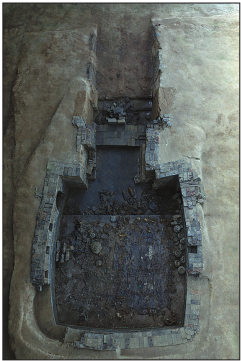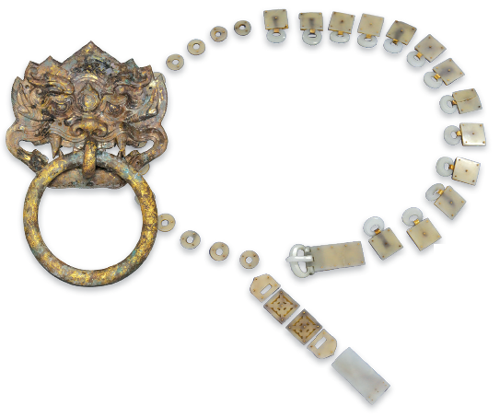
CHINA DAILY
The tomb of Emperor Yang Guang (AD 569-618) was recently unearthed in Yangzhou, Jiangsu province.

CHINA DAILY
Valuable relics found in the emperor's burial site include four lion-shaped doorknockers and a 13-ring jade belt decorated with gold.
One of the worst and most spendthrift tyrants in Chinese history has been found buried in a shabby tomb in Yangzhou, East China's Jiangsu province, by China's top archaeologists.
The tomb was unearthed in Xihu township of Hanjiang district in April this year and this month, archaeologists confirmed that it belonged to Yang Guang, the second and final emperor of the short-lived Sui Dynasty (AD 581-618).
Emperor Yang Guang (AD 569-618) reigned over the country for about 14 years. Historical books state that he was an elegant and clever man. But Chinese historians generally agree that his tyranny brought about the demise of the Sui Dynasty.
Despite Yang's tyranny, he also completed several great construction projects during his reign, including the Grand Canal and the reconstruction of some parts of the Great Wall. He also officially established the imperial examination, a civil service examination system to select talent to serve the government in imperial China. The system lasted for about 1,300 years.
The once elegant emperor, who left behind more than 40 poems, now has only two teeth left as he sits in his final resting place, a square-shaped catacomb made of bricks.
Identification of the two teeth also shows that their owner should be about 50 years old, which was Yang's age when he was killed in a rebellion.
The catacomb is only 24.48 meters long, 8.22 meters wide and 2.76 meters high. It consists of a main hall, two rooms to the east and west, and two corridors leading to the hall and the main entrance.
To the southeast of Yang's catacomb lies his wife's tomb, which has a similar structure. Empress Xiao's tomb is 12.64 meters long, 5.9 meters wide and 1.6 meters high. Compared with Yang's, her skeleton is much better preserved.
Experts from Nanjing University identified the skeletal remains found in the tomb and said they are from a person about 56 years old and 1.5 meters tall. This conforms to descriptions of Empress Xiao in Chinese history books.
Wang Wei, director of the institute of archaeology under the Chinese Academy of Social Sciences, says the text inscribed on a tablet found in Yang's tomb is the key piece of evidence that proves the owners' identities.
"By using the most advanced 3-D scanning identification technology in China, we retrieved some parts of the text, which described the title and the life of Yang," Wang says.
"Some parts of Yang's tomb have collapsed and it was visited by grave robbers, which could explain why his remains were not as well preserved as Empress Xiao's," says Shu Jiaping, director of Yangzhou's archaeological bureau. "Also, the acidic soil of the Yangtze Delta is not good for preservation of remains."
Liu Qingzhu, a researcher from the institute of archaeology under the Chinese Academy of Social Sciences, says Emperor Yang rested in a shabby tomb because he had lost his identity as an emperor when he was buried by the founders of the next dynasty-the Tang Dynasty (AD 618-907).
"As an emperor of a dead empire, Yang couldn't be buried in a mausoleum that had the structure of a normal monarch's," Liu says.
Still, a large number of rare treasures were unearthed from the two tombs, including some that could only be used by royal family members.
More than 300 treasures made of jade, bronze, iron, pottery, wood and lacquer in various forms, including animals, soldiers and a snake-shaped man with two heads, were found in the two tombs.
Among them a 13-ring jade belt decorated with gold is considered of extreme value. Xu Guobin, deputy director of the archaeological bureau in Yangzhou, says it is the most complete jade belt unearthed in China, and the belt could only have been used by people with the highest social status.
Also, four lion-shaped doorknockers made of gold and bronze with a diameter of 26 cm, and 36 ancient percussion instruments made of bronze bells and L-shaped jade plates are considered to be important relics.
The discovery of Emperor Yang's real tomb leaves another mausoleum, which had been considered as the imperial burial site for about 200 years, in an awkward position.
The fake mausoleum, which is about 6 km away from the two tombs, has magnificent memorial arches, tomb doors and walls, and occupies an area of 30,000 square meters. It had been thought to be Yang's burial site since the Qing Dynasty (1644-1911) and been a tourist attraction in Yangzhou since the 1980s.
Contact the writers at cangwei@chinadaily.com.cn and songwenwei@chinadaily.com.cn.
We recommend:
